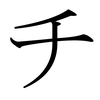- Chi (kana)
-

Hiragana
KatakanaTransliteration: chi, ti Hiragana Man'yōgana: 知 Katakana Man'yōgana: 千 kana gojūon n wa ra ya ma ha na ta sa ka a sokuon wi ri mi hi ni chi shi ki i dakuten ru yu mu fu nu tsu su ku u chōonpu we re me he ne te se ke e wo ro yo mo ho no to so ko o ち, in hiragana, or チ in katakana, is one of the Japanese kana, which each represent one mora. Both are phonemically /ti/ although for phonological reasons, the actual pronunciation is [t͡ɕi] (
 listen).
listen).The kanji for one thousand (千, sen), appears similar to チ, and at one time they were related, but today チ is used as phonetic, while the kanji carries an entirely unrelated meaning .
Many onomatopoeic words beginning with ち pertain to things that are small or quick.[1]
The dakuten forms ぢ, ヂ, pronounced the same as the dakuten forms of the shi kana in most dialects (see yotsugana), are uncommon. They are primarily used for indicating a voiced consonant in the middle of a compound word (see rendaku), and they can never begin a word, although some people will write the word for hemorrhoids (normally じ) as ぢ for emphasis. Additionally, the dakuten form of the shi character is sometimes used when transliterating "di", as opposed to チ's dakuten form; for example, Aladdin is written as アラジン Arajin, and radio is written as ラジオ.
In the Ainu language, チ by itself is pronounced [tʃi], and can be combined with the katakana ヤ, ユ, エ, and ヨ to write the other [tʃ] sounds as well as [ts] sounds. The combination チェ (pronounced [tse]), is interchangeable with セ゚.
Contents
Form variants
Form Rōmaji Hiragana Katakana Normal ch-
(た行 ta-gyō)chi ち チ chii
chīちい, ちぃ
ちーチイ, チィ
チーAddition yōon ch-
(ちゃ行 cha-gyō)cha ちゃ チャ chaa
chā, chahちゃあ
ちゃーチャア
チャーchu ちゅ チュ chuu
chūちゅう
ちゅーチュウ
チューcho ちょ チョ chou
choo
chō, chohちょう
ちょお
ちょーチョウ
チョオ
チョーAddition dakuten d- (j/z-)
(だ行 da-gyō)di (ji, zi) ぢ ヂ dii (jii, zii)
dī (jī, zī)ぢい, ぢぃ
ぢーヂイ, ヂィ
ヂーAddition yōon and dakuten dy- (j-)
(ぢゃ行 dya-gyō)dya (ja) ぢゃ ヂャ dyaa (jaa)
dyā (jā), dyah (jah)ぢゃあ
ぢゃーヂャア
ヂャーdyu (ju) ぢゅ ヂュ dyuu (juu)
dyū (jū)ぢゅう
ぢゅーヂュウ
ヂューdyo (jo) ぢょ ヂョ dyou (jou)
dyoo (joo)
dyō (jō), dyoh (joh)ぢょう
ぢょお
ぢょーヂョウ
ヂョオ
ヂョーOther additional forms Form A (ch-) Romaji Hiragana Katakana (cha) (ちゃ) (チャ) (chi) (ち) (チ) (chu) (ちゅ) (チュ) che ちぇ チェ (cho) (ちょ) (チョ) Form B (dy/j-) Romaji Hiragana Katakana (dya, ja) (ぢゃ) (ヂャ) (dyi, ji) (ぢぃ, ぢ) (ヂィ, ヂ) (dyu, ju) (ぢゅ) (ヂュ) dye (je) ぢぇ ヂェ (dyo, jo) (ぢょ) (ヂョ) Stroke order
See also
References
- ^ Hiroko Fukuda, Jazz Up Your Japanese with Onomatopoeia: For All Levels, trans. Tom Gally. New York: Kodansha International (2003): 19 - 20, Introduction, Words Beginning with ち Chi, Indicating Smallness or Quickness.
Categories:- Specific kana
- Writing system stubs
Wikimedia Foundation. 2010.




